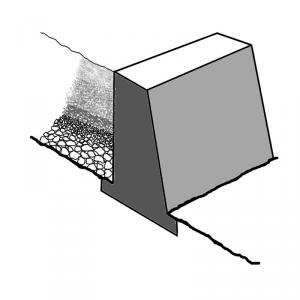Executive Summary
Sand dams and subsurface dams (both some times called more general groundwater dams) store water under the ground. A sand dam is a small dam build above ground and into the riverbed of a seasonal sand river. Sand accumulates upstream of the dam, resulting in additional groundwater storage capacity. Similar to sand dam a subsurface dam obstructs the groundwater flow of an aquifer and stores water below ground level. Sand and subsurface dams are suitable for rural areas with semi-arid climate in order to store only seasonal available water to be used in dry periods for livestock, minor irrigation as well as for domestic use. They can be built with locally available material and labour but building a dam still requires relatively high investments, is labour intensive and specific expertise is needed.
| In | Out |
|---|---|
Freshwater |
Introduction
Decentralised storage of water is an important strategy in drylands like semi-arid and arid regions outside the reach of perennial rivers, springs, deep groundwater or other water sources.According to ED (n.y.) 40% of the world’s land surface is classed as ‘drylands’, which sustains 80% of the world’s poorest people.
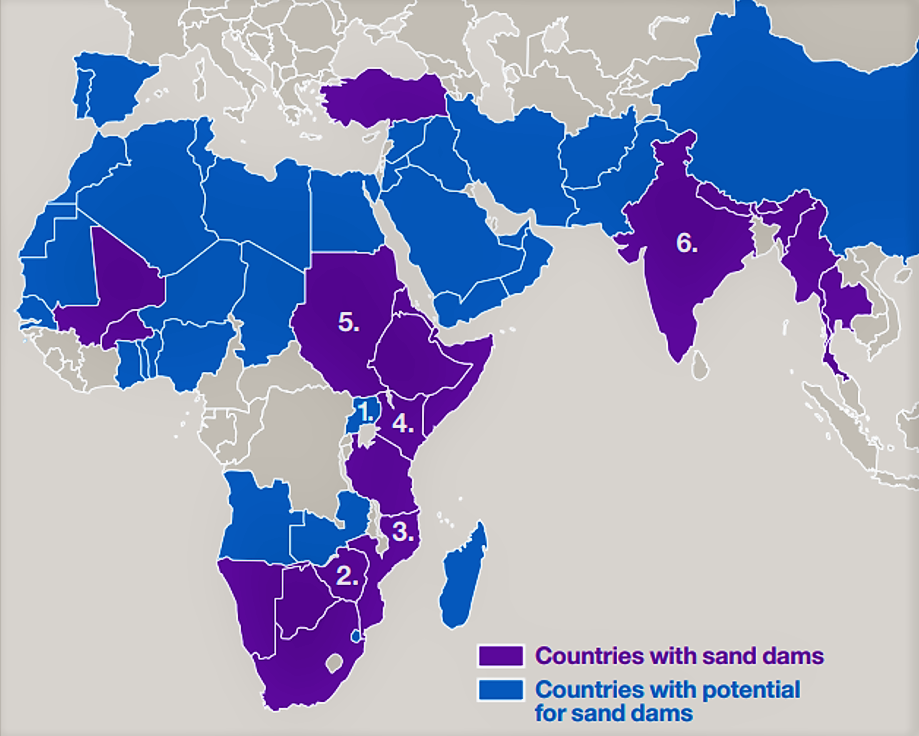
Storage of water from the rainy season to the dry season, or even from wet years to dry years is highly important in such areas. Sand dams and subsurface dams (more general called groundwater dam, VSF 2006) can store sufficient quantities of water for livestock and minor irrigation as well as for domestic use. If sited and built properly, dams can give an appropriate answer to the water need. Unfortunately there are also many examples of groundwater dams, which have not been successful due to insufficient technical and social assessment and design.
Sand Dams
A sand dam is a small dam built above ground and into the riverbed of a seasonal sand river, conditions that are found across the world’s drylands. Its purpose is to capture and store water beneath sand (ED n.y.): upstream of a sand dam sand accumulates, resulting in additional groundwater storage capacity of riverbed and riverbanks. This reservoir fills during the wet season, preventing quick runoff of valuable rainwater out of the catchment and out of the reach of the community. Water availability during dry seasons is prolonged and generally guaranteed. The quality of the water is protected against evaporation and contamination. Water quality is even improved through natural filtration in the soil (similar to what happens in a biosand filter). The technique of sand storage dams is not new: storage of rainfall and runoff, including subsurface storage, for beneficial use has been applied since 9,000 BC (HOOGMOED 2009).

Basic design principles
Before starting a sand dam project in an area, the community must be intensively involved to create a feeling of ownership, which has proven to be the key factor in successful construction and maintenance of sand dams (see also RAIN n.y.; decision making, demand creation, stakeholder analysis and visioning). Different types of sand dams can be distinguished (adapted from RAIN n.y.):
- Stone-masonry dam: A dam built of concrete blocks or stones. Local artisan can easily construct this type of dam. A stone-masonry dam is durable and suitable for any dam height. The dam is cheap when construction materials are available within the dam area.
- Reinforced concrete dam: A dam consisting of a thin wall made of reinforced concrete. It is a durable structure, relatively expensive but suitable for any dam height.
- Earth dam: A dam consisting of impermeable soil material (mostly clay or clayey soils, or black soils). This type of dam is relatively expensive to construct and it requires special skills for its design and construction. An earth dam can easily be damaged and even destroyed by underground flow. Earth dams are not popular and are seldom used (only for minor works).
Site selection and construction
(Adapted from PRACTICAL ACTION n.y.)
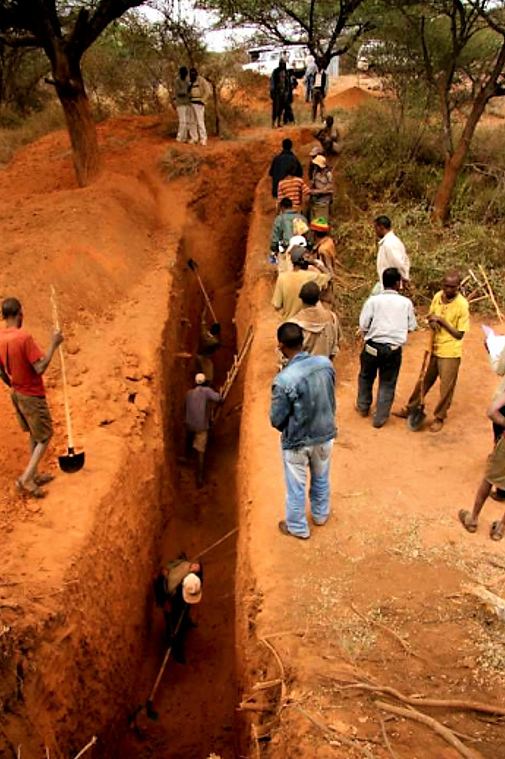
The first step is to carry out a site survey, which involves analysing the geological and physical characteristics of the site, especially the underlying rock structures and soil properties. Riverbeds with crystalline rocks and coarse sand have higher yield compared with volcanic rocks. Similarly, river valleys and regions sloping between 1 and 2% are ideal sites for sand dams as they normally give the highest water storage. Knowledge of hydrological data is important for estimating the total stream flow, size of river transportation thereby influencing the thickness and height if the wall. Information on geological and topographical characteristics and even hydrological data can all be sourced from relevant Government departments.
The second step is to obtain the required tools and materials. Essential materials include waterproof Portland cement, nails, binding wire, timber, sand and stones, which are sometimes readily available along the riverbeds. Other equipment includes spade, sledgehammer, shovels, wheelbarrows, power mixer and water containers. Where stones are readily available, masonry sand dams are recommended; otherwise concrete walls are equally strong and durable. To construct sand dam a deep trench is first dug across the valley wall or stream, reaching the bedrock or other stable layer like clay. To cut costs, local labour should be mobilised and involved in this process (community involvement).
A concrete or masonry wall is then built on the underlying rock bars across the river channels so that it can trap and hold back the sand brought by the river during flooding. The height may range between 2 to 5m high depending on the depth of the underlying rock or other stable layer.
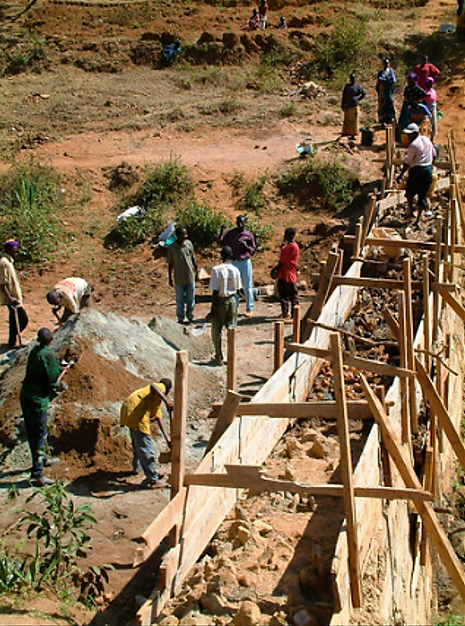
At either end of the dam especially where the valley sides are flat wing walls may be added at an angle to the main dam to direct and confine the flows of channel as the sand stores water in its spores. Since the natural sorting and deposition of sediments in streams is a function of channel slope and the shape of channel cross section, channel geometry is quite important in sighting the prospective sand dam. While channel slopes may vary in different valleys and regions a slope of between 1 and 2% normally gives the highest water storage. The specific storage normally increases at the lower slopes than the higher ones.
After the construction of a sand dam, a new channel cross section is created together with new gentler channel slope immediately upstream of the dam. The modified channel must safely pass the highest expected flood without overflowing the banks and threatening the bank abutments. In addition to rock outcrops for firm foundations, high riverbanks are another desirable feature. Where banks are low the dam has to be raised on either or both sides and wing walls extended beyond the banks in order to direct floodwater and prevent it from cutting around the dam.

NISSEN-PETERSEN (2006) promotes a different construction method, where the dam and the spillway is heightened sequently with each flooding, in order to catch only the coarse sand and to allow the finer material to be washed downstream (see training material for further information).
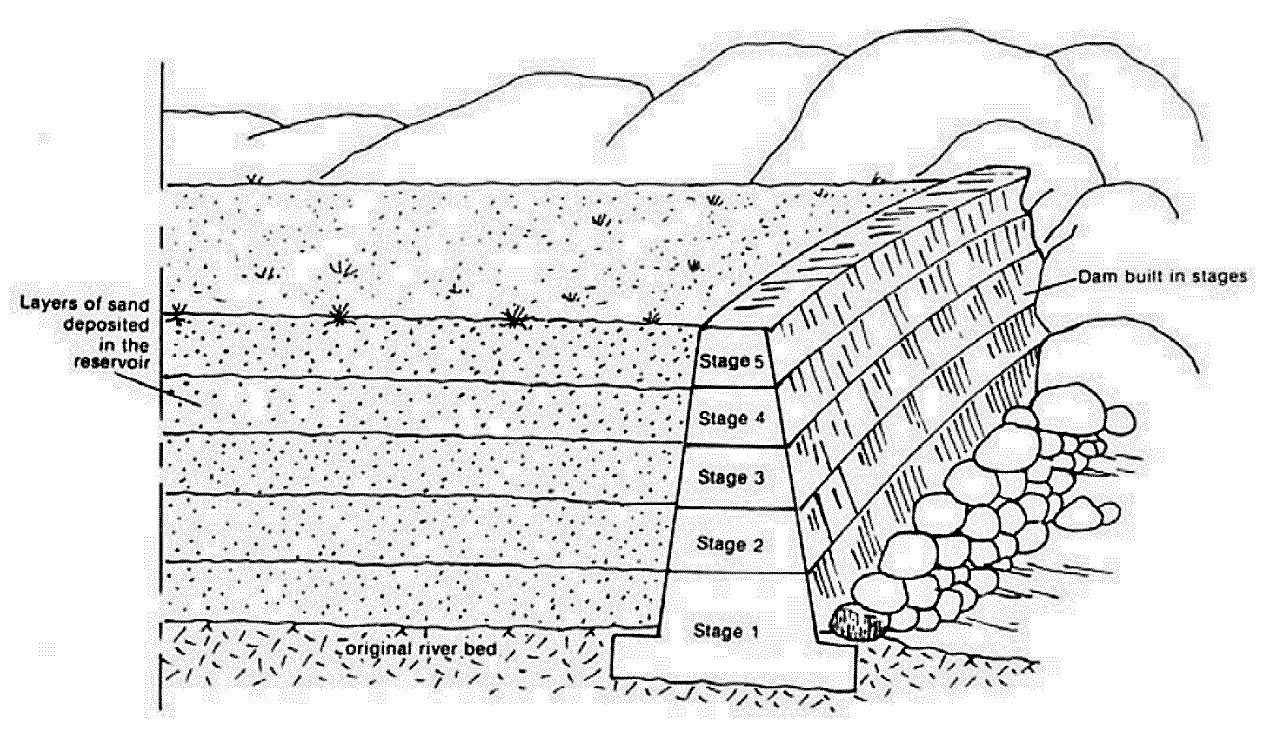
Water extraction from sand dam
(Adapted from RAIN n.y.)
Scoop hole: the most common way to abstract water from a sand storage dam is by means of a hand dug scoop hole in the riverbed. Water is scooped out at first, and the water that refills the scoop hole is abstracted. This method is susceptible for pollution, especially by animals.
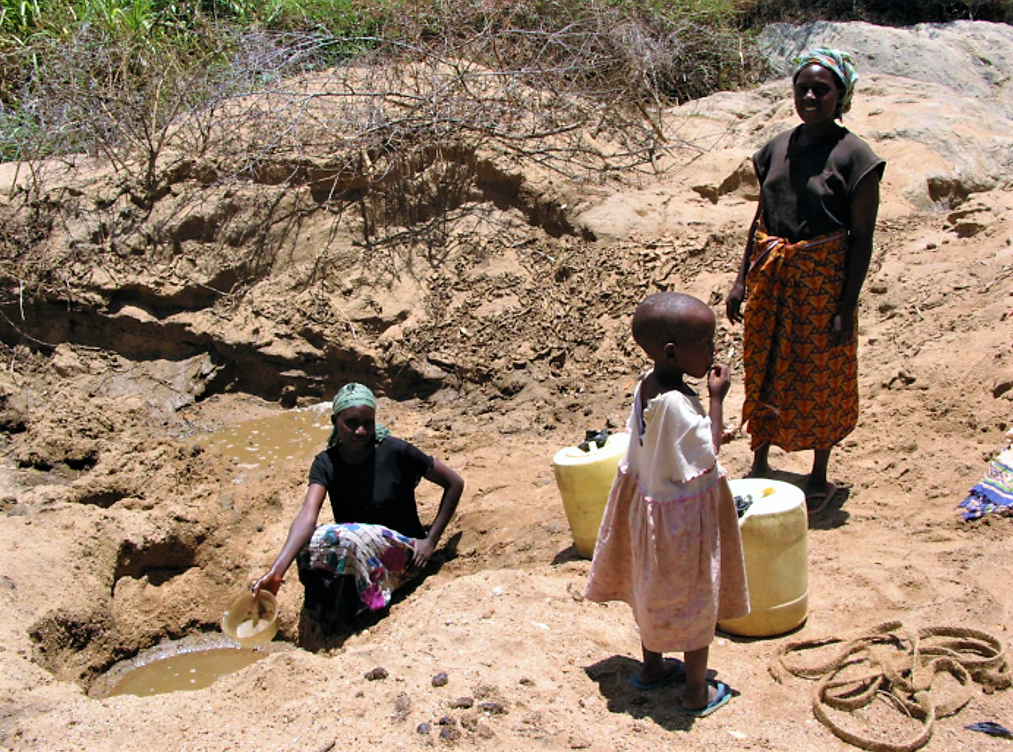
Well with hand-or rope pump: a well is the better alternative for a scoop hole. It will protect the water quality because animals and river water cannot enter. Many different types of wells exist. A well need to be covered (to prevent contamination, resulting in higher water quality) and a hand pump should be used to extract water.
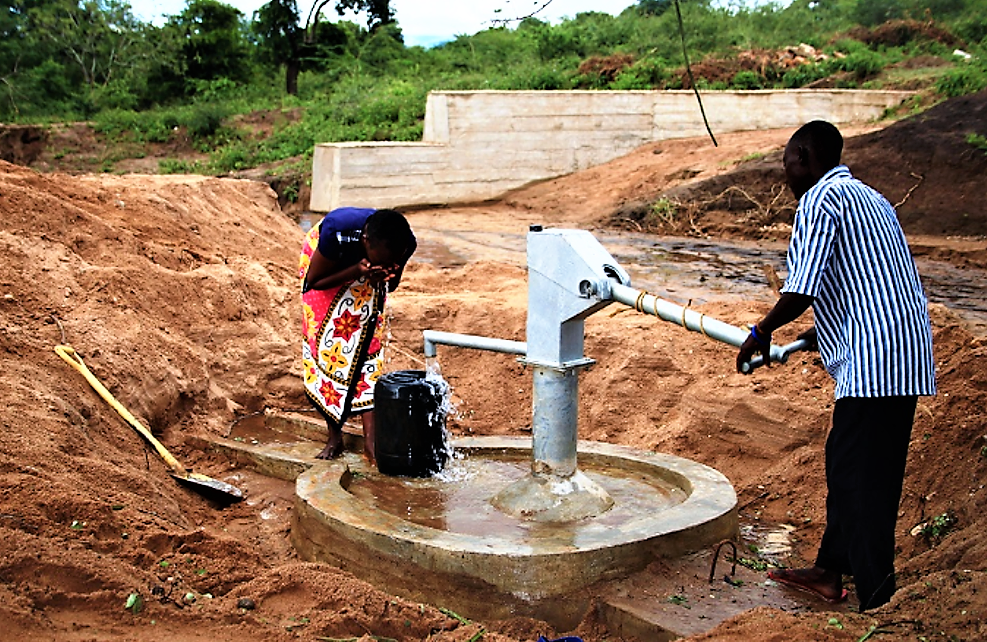
Outlet pipe with tap: An outlet can be installed as a perforated pipe at the bottom of the dam just above the impermeable layer. The pipe should be covered fully with filter material and geo-membrane to prevent entry of sand and silt. Disadvantages of an outlet, is that it can weaken the dam structure, maintenance is complicated and it is also found be an expensive option.
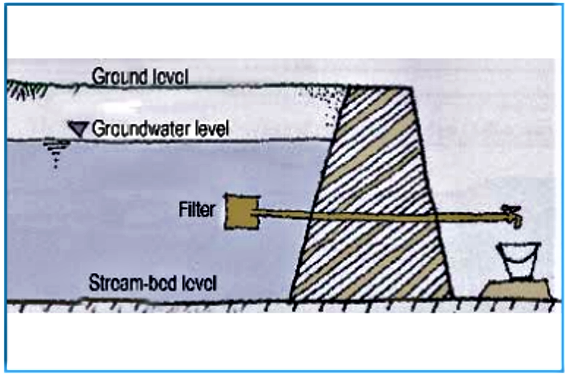
Subsurface dam
(Adapted from VSF 2006)
A subsurface dam obstructs the groundwater flow of an aquifer and stores water below ground level. It is built entirely under the ground.
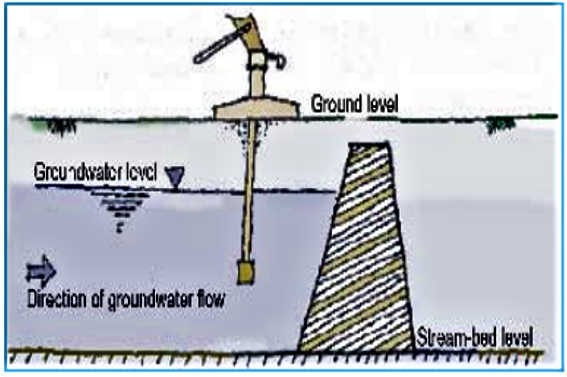
Basic design principle, site selection and construction
Similarly, when a sand dam is constructed it is necessary to excavate a trench in the sand bed in order to reach bedrock, which can be used to create a subsurface dam too. Groundwater dams are built across streams or valleys. A trench is dug across the valley or stream, reaching to the bedrock or other stable layer like clay. An impervious wall is constructed in the trench, which is then refilled with the excavated material. A subsurface dam is constructed below ground level and arrests the flow in a natural aquifer. The best sites for construction of groundwater dams are those where the soil consists of sands and gravel, with rock or an impermeable layer at a few metres’ depth. Ideally, the dam should be built there where rainwater from a large catchment area flows through a narrow passage.
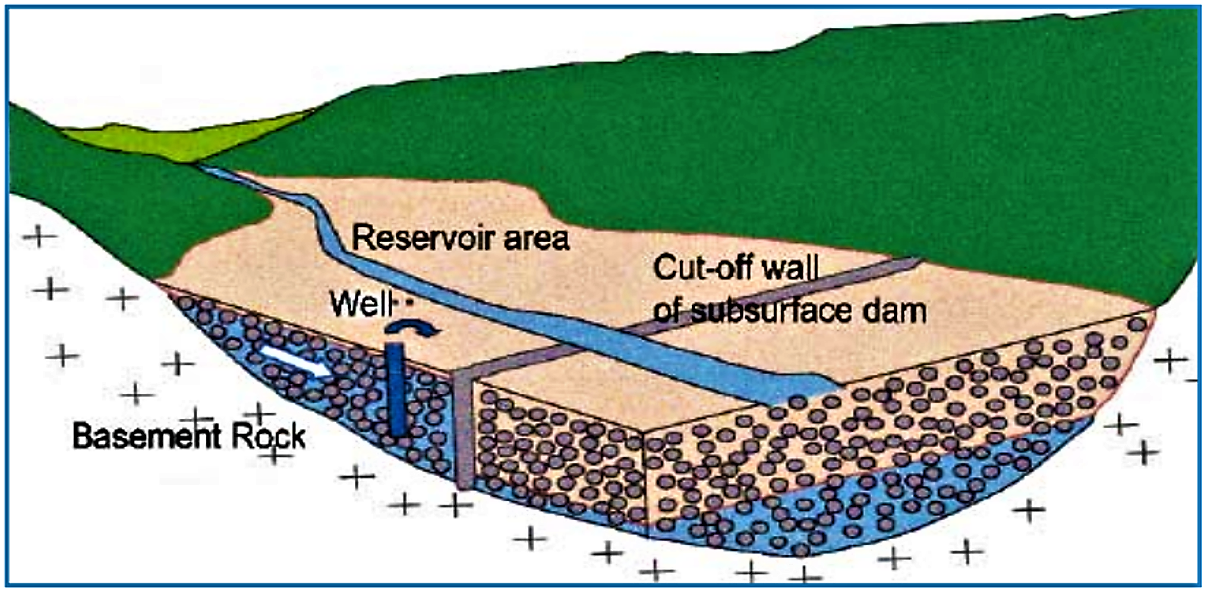
The optimum zone for constructing a subsurface dam is generally found on gentle slopes in the transition zone between hills and plains. Finding suitable places to build the dam is harder when the river is wider. In view of an efficient reservoir it is important that it is based upon impermeable beds or bedrock are underlying the reservoir. In general the topographical gradient of the construction sites is between 0.2 to 4%, but in extreme cases slopes of 10 to 16 % have been used (NILSSON 1988). Underground reservoirs in sand-rivers are principally recharged by rainwater from flash floods, which originate in catchment areas with higher elevation. A single and short-lived flash flood may fully recharge a reservoir with water. Upon full saturation of the reservoir, the remaining flash floods will pass over the dam without further infiltration, replenishing aquifers downstream. The water is extracted through a well, which may be placed in the reservoir or by a gravity pipeline if the topographical conditions are favourable.
Difference between subsurface dams and sand dams
(Adapted from VSF 2006)
As becomes clear from the figures, the general principle of sand storage dams and subsurface dams is similar. In general, sand dams are used when the topographical gradient is high and subsurface dams are used when the topographical gradient is low. If the impervious layer lies near the surface, the storage capacity of the basin will be low. A sand storage dam will enlarge the storage, while a subsurface dam only uses the storage capacity under the surface. When the river is narrow and has high embankments, the storage capacity of a sand storage dam can easily be enlarged. The embankments provide a good anchoring possibility.
Cost consideration
The cost of an average sand dam with a minimum life span of 50 years and storage of at least 2.000 m3 is about US$ 7.500 (2-4 meters height and 20 meters length; example from Kenya; see case studies in RAIN n.y.). In the case study of Kenya the community covered about 40% of the overall construction costs by being involved in the construction of sand storage dams by provision of labour and raw materials through sand dam management groups (RAIN n.y.).
According to NISSEN-PETERSEN (2006), subsurface dams are less expensive and easier to maintain than sand dams, but do have less capacity. Subsurface dams, basically made out of clay, were constructed in Kenya, with a capacity of 425 to 1342 m3 and at a cost of 900 to USD1600 (VSF 2006).
Health aspects
According to PRACTICAL ACTION (n.y.)the water is clean and of good quality for consumption due to filtering effect of the sand. Concerning sand dams: if scoop holes are used for water extraction, attention should be given regarding pollution from animals. Animals and humans should use different scoop holes far apart from each other. And the human’s one should be located close to the dam (RAIN n.y.). Read more about water pollution and water borne diseases.
At a glance
| Working principle | A sand dam is constructed across the river channel. During rain events (flooding) sand accumulates until the dam is completely full of sand up to the spillway. Water is stored within the sand, protected and filtered, making up to 40 % of the total volume. A subsurface dam has a similar working principle as a sand dam. The dam is constructed below ground level and arrests the flow in a natural aquifer |
| Capacity/adequacy | With proper siting the total amount of water available in the sand dams can be over 6000m3. This technique is applicable in sandy riverbeds that are seasonally dry but experiences high siltation during water runoffs. Sites with high riverbanks and lower slopes are also desirable (PRACTICAL ACTION n.y.). Subsurface dams have less capacity than sand dams with storage capacity ranging from about 400 to 1800 m3 (VSF 2006). |
| Costs | The cost of an average sand storage dam with a minimum life span of 50 years and storage of at least 2.000 m3 is about US$ 7.500 (2-4 meters height and 20 meters length; example from Kenya; RAIN n.y.). Subsurface dams, basically made out of clay, were constructed in Kenya, with a capacity of 425 to 1,342 m3 and at a cost of 900 to US$ 1600 (VSF 2006). |
| Self-help compatibility | Expert design required. |
| O&M | If a sand dam or subsurface dam is properly built, it only requires little or no major maintenance (RAIN n.y.; VSF 2006). According to NISSEN-PETERSEN (2006) Sand dams require careful maintenance, and immediate repair, if necessary, as flooding causes hundreds of tonnes of water to fall over the dam wall and onto the spill-over apron. Floodwater may also spill over and erode the wing walls and, perhaps, even over the riverbanks during heavy rains. In contrast to sand dams, subsurface dams do are not exposed to forces of floods, since the dam is below ground (VSF 2006). |
| Reliability | If well constructed and maintained drinking water in good quality is available. |
| Main strength | Simple inexpensive technology is used and the dam can be constructed by local communities mainly with locally available materials (RAIN n.y.). |
| Main weakness | The technology is labour and physical capital intensive and most local communities cannot implement it without external aid (PRACTICAL ACTION n.y.).
|
Sand and subsurface dams can be built in rural areas, anywhere there are seasonal rivers with coarse sandy sediment and where the river is underlain by impervious bedrock (or clays like black cotton soil) – conditions that are found in arid and semi-arid regions (ED n.y.; RAIN n.y.).
Hydrology of Sand Storage Dams. A Case Study in the Kiindu Catchment, Kituï District, Kenya
This report reflects the results of a research project concerning the hydrology around sand storage dams in the Kitui district, one of the arid and semi-arid lands of Kenya, where most people rely heavily on water supply from the riverbeds of seasonal rivers.
BORST, L. HAAS, S.A. de (2006): Hydrology of Sand Storage Dams. A Case Study in the Kiindu Catchment, Kituï District, Kenya. Amsterdam: Vrije University URL [Accessed: 20.04.2011] PDFTwo local people fetching water using a hand pump from a closed well near a sand dam
Pioneers of Sand Dams
This brochure highlights the features of sand dams using helpful illustrations.
ED (n.y): Pioneers of Sand Dams. Brentford: EXCELLENT DEVELOPMENT (ED) PDFAnalysis of the Functioning of Sand Storage Dams in Kenya
Analyses of impacts of a sand storage dam on groundwater flow and storage
Large parts of the world cope with problems of water supply during periods of low rainfall and consequent low or no river discharge. Kitui District is a semi arid region in Kenya where, during the dry season, communities in rural areas almost completely rely on water abstraction through hand-dug wells (scoop holes) in the dry sand riverbeds. To increase water availability during the dry season, SASOL (a local NGO) builds sand storage dams. The construction of sand dams has turned out to be very successful in increasing groundwater storage capacity, prolonging the period of groundwater availability (bridging dry seasons) and improving water quality.
HOOGMOED, M. (2007): Analyses of impacts of a sand storage dam on groundwater flow and storage. Amsterdam: Vrije University URL [Accessed: 20.12.2011] PDFAn Introduction into Sand Storage Dams (SSD)
Model Project to combat Desertification. In Nare Village, Burkina Faso
This detailed technical report presents a large-scale project of a subsurface dam implemented in Burkina Faso.
MOE (2004): Model Project to combat Desertification. In Nare Village, Burkina Faso. (= Technical Report of the Subsurface Dam ). Tokyo: Ministry of the Environment (MOE) URL [Accessed: 14.03.2019] PDFGroundwater Dams for small-scale Water Supply
A practical guide to Sand Dam Implementation: Water Supply through local Structures as Adaption to Climate Change
Two case studies from Kenya and Ethiopia are briefly presented at the beginning of the document.
RAIN (n.y): A practical guide to Sand Dam Implementation: Water Supply through local Structures as Adaption to Climate Change. Amsterdam: Rainwater Harvesting Implementation Network (RAIN) URL [Accessed: 20.04.2011] PDFSand Dam Construction
Newly-constructed Sand Dam
SubSurface Dams: a simple, safe and affordable Technology for Pastoralists. A manual on SubSurface Dams Construction based on an Experience of Vétérinaires sans Frontières in Turkana District (Kenya)
This manual builds on the experience of VSF with subsurface dams in Kenya, explaining all phases from the initial assessment to the design of the dams based on the own lessons learned with this specific technique.
VSF (2006): SubSurface Dams: a simple, safe and affordable Technology for Pastoralists. A manual on SubSurface Dams Construction based on an Experience of Vétérinaires sans Frontières in Turkana District (Kenya). Brussels: Vétérinaires sans Frontières (VSF) URL [Accessed: 14.03.2019] PDFWater from Dry Riverbeds - How Dry and Sandy Riverbeds Can be Turned into Water Sources by Hand-dug Wells, Subsurface Dams, Weirs and Sand Dams
Chapter 7 of this handbook provides technical guidance for design and construction of sand dams. The author also presents interesting cases, where sand dams were constructed wrong or maintenance was neglected.
NISSEN-PETERSEN, E. (2006): Water from Dry Riverbeds - How Dry and Sandy Riverbeds Can be Turned into Water Sources by Hand-dug Wells, Subsurface Dams, Weirs and Sand Dams. Nairobi: ASAL Consultants Ltd. URL [Accessed: 11.03.2011] PDFSand Dams or Silt Traps
In this document Nissen-Petersen criticises sand dams, which failed due to wrong implementation. He promotes a different method of construction, which is presented in this document (see also NISSEN-PETERSEN, training material).
NISSEN-PETERSEN, E. (2011): Sand Dams or Silt Traps. Nairobi: ASAL Consultants Ltd. URL [Accessed: 20.04.2011] PDFJoin the Wave with Erik Nissen-Petersen: Are Sand Dams the Solution for Water Harvesting
In this critical interview Erik Nissen-Petersen explains different options for water harvesting and shows why sand dams are the most complicated structures to build.
THEWATERCHANNEL (2010): Join the Wave with Erik Nissen-Petersen: Are Sand Dams the Solution for Water Harvesting. THEWATERCHANNEL URL [Accessed: 20.04.2011] PDFTechnology Notes
These technology notes have been prepared following many general enquiries for technical information having been received by WaterAid over the years. Their purpose is to give an outline of the technologies used by WaterAid on long-term development projects in Africa and Asia, and to show alternatives, which might be appropriate in different circumstances. It may be possible to determine from the notes the technology, which would be appropriate in a particular location.
WATERAID (2008): Technology Notes. London: WaterAid URL [Accessed: 04.01.2011] PDFA Study to Upscaling of the Principle and Sediment (Transport) Processes behind Sand Storage Dams, Kitui District, Kenya
A study on the upscaling of the sand storage dam and the sedimentation processes that occur in the surroudings of the sand storage dam.
GIJSBERTSEN, C. (2007): A Study to Upscaling of the Principle and Sediment (Transport) Processes behind Sand Storage Dams, Kitui District, Kenya. Master Thesis Hydrogeology. Amsterdam: Vrije University URL [Accessed: 29.02.2012] PDFRainwater Harvesting for Natural Resources Management; A planning Guide for Tanzania
A planning handbook that provides planners with practical tips on how rainwater harvesting can form an integrated part of district development efforts. The book also gives practical guidelines in the planning steps required to incorporate rainwater harvesting in development plans, and shows how to implement them in the farmers’ context.
HATIBU, N. MAHOO, H.F. (2000): Rainwater Harvesting for Natural Resources Management; A planning Guide for Tanzania . Stockholm: Sida's Regional Land Management Unit URL [Accessed: 29.02.2012] PDFSand Dams: The World's most Cost-Effective Method of Conserving Rainwater
This short but excellent brochure explains everything about sand dams.
EXCELLENT (2012): Sand Dams: The World's most Cost-Effective Method of Conserving Rainwater. Brentford: Excellent PDFWater Harvesting
Water harvesting has been practiced successfully for millennia in parts of the world – and some recent interventions have also had significant local impact. Yet water harvesting’s potential remains largely unknown, unacknowledged and unappreciated. These guidelines cover a wide span of technologies from large-scale floodwater spreading to practices that collect and store water from household compounds.
MEKDASCHI STUDER, R. LINIGER, H. (2013): Water Harvesting. Guidelines to Good Practice. Bern/Amsterdam/Wageningen/Rome: Centre for Development and Environment (CDE), Rainwater Harvesting Implementation Network (RAIN), MetaMeta, The International Fund for Agricultural Development (IFAD) URL [Accessed: 12.03.2019] PDFHydrology of Sand Storage Dams. A Case Study in the Kiindu Catchment, Kituï District, Kenya
This report reflects the results of a research project concerning the hydrology around sand storage dams in the Kitui district, one of the arid and semi-arid lands of Kenya, where most people rely heavily on water supply from the riverbeds of seasonal rivers.
BORST, L. HAAS, S.A. de (2006): Hydrology of Sand Storage Dams. A Case Study in the Kiindu Catchment, Kituï District, Kenya. Amsterdam: Vrije University URL [Accessed: 20.04.2011] PDFPotential for community based adaptation to droughts: Sand dams in Kitui, Kenya
This paper presents the results of an evaluation of the effects of local small scale sand dam projects in Kenya.
LASAGE, R. ; AERTS, J. ; MUTISO, G.C.M. ; VRIES, A. de (2008): Potential for community based adaptation to droughts: Sand dams in Kitui, Kenya. In: Physics and Chemistry of the Earth : Volume 33 , 67–73. URL [Accessed: 20.04.2011] PDFModel Project to combat Desertification. In Nare Village, Burkina Faso
This detailed technical report presents a large-scale project of a subsurface dam implemented in Burkina Faso.
MOE (2004): Model Project to combat Desertification. In Nare Village, Burkina Faso. (= Technical Report of the Subsurface Dam ). Tokyo: Ministry of the Environment (MOE) URL [Accessed: 14.03.2019] PDFUnderground Dams. A Tool of Sustainable Development and Management of Groundwater Resources
This paper presents groundwater flow simulations, which according to the author could be useful for planning and design of groundwater dams.
ONDER, H. ; YILMAZ, M. (2005): Underground Dams. A Tool of Sustainable Development and Management of Groundwater Resources. In: European Water : Volume 11 , 35-45. URL [Accessed: 10.05.2011] PDFA practical guide to Sand Dam Implementation: Water Supply through local Structures as Adaption to Climate Change
Two case studies from Kenya and Ethiopia are briefly presented at the beginning of the document.
RAIN (n.y): A practical guide to Sand Dam Implementation: Water Supply through local Structures as Adaption to Climate Change. Amsterdam: Rainwater Harvesting Implementation Network (RAIN) URL [Accessed: 20.04.2011] PDFAnalyses of impacts of a sand storage dam on groundwater flow and storage
Large parts of the world cope with problems of water supply during periods of low rainfall and consequent low or no river discharge. Kitui District is a semi arid region in Kenya where, during the dry season, communities in rural areas almost completely rely on water abstraction through hand-dug wells (scoop holes) in the dry sand riverbeds. To increase water availability during the dry season, SASOL (a local NGO) builds sand storage dams. The construction of sand dams has turned out to be very successful in increasing groundwater storage capacity, prolonging the period of groundwater availability (bridging dry seasons) and improving water quality.
HOOGMOED, M. (2007): Analyses of impacts of a sand storage dam on groundwater flow and storage. Amsterdam: Vrije University URL [Accessed: 20.12.2011] PDFWater from Dry Riverbeds - How Dry and Sandy Riverbeds Can be Turned into Water Sources by Hand-dug Wells, Subsurface Dams, Weirs and Sand Dams
Chapter 7 of this handbook provides technical guidance for design and construction of sand dams. The author also presents interesting cases, where sand dams were constructed wrong or maintenance was neglected.
NISSEN-PETERSEN, E. (2006): Water from Dry Riverbeds - How Dry and Sandy Riverbeds Can be Turned into Water Sources by Hand-dug Wells, Subsurface Dams, Weirs and Sand Dams. Nairobi: ASAL Consultants Ltd. URL [Accessed: 11.03.2011] PDFA practical guide to Sand Dam Implementation: Water Supply through local Structures as Adaption to Climate Change
Two case studies from Kenya and Ethiopia are briefly presented at the beginning of the document.
RAIN (n.y): A practical guide to Sand Dam Implementation: Water Supply through local Structures as Adaption to Climate Change. Amsterdam: Rainwater Harvesting Implementation Network (RAIN) URL [Accessed: 20.04.2011] PDFSubSurface Dams: a simple, safe and affordable Technology for Pastoralists. A manual on SubSurface Dams Construction based on an Experience of Vétérinaires sans Frontières in Turkana District (Kenya)
This manual builds on the experience of VSF with subsurface dams in Kenya, explaining all phases from the initial assessment to the design of the dams based on the own lessons learned with this specific technique.
VSF (2006): SubSurface Dams: a simple, safe and affordable Technology for Pastoralists. A manual on SubSurface Dams Construction based on an Experience of Vétérinaires sans Frontières in Turkana District (Kenya). Brussels: Vétérinaires sans Frontières (VSF) URL [Accessed: 14.03.2019] PDFManual on Sand Dams in Ethiopia
A practical approach on sand dam site selection, design and construction. A tool for combining sand dams with other rainwater harvesting structures.
ERHA ; RAIN (n.y): Manual on Sand Dams in Ethiopia. Addis Ababa and Amsterdam: Ethiopian Rainwater Harvesting Association (ERHA) and Rainwater Harvesting Implementation Network (RAIN) URL [Accessed: 14.03.2019] PDFPioneers of Sand Dams
This brochure highlights the features of sand dams using helpful illustrations.
ED (n.y): Pioneers of Sand Dams. Brentford: EXCELLENT DEVELOPMENT (ED) PDFExcellent Development - Pioneers of Sand Dams
This NGO promotes sand dams and explains briefly the features of sand dams.
Excellent Development - Sand Dams in Kenya
This documentary film about Sand dams in Kenya provides a brief introduction into the problematic of water scarcity and how sand dam technology contributes to solve the problem.
Sub-surface Dams, Small Dams, and Sand Dams
This website provides a short overview over subsurface dam.
Underground dams in Brazil
This document gives a brief technical overview over subsurface dams (underground dam).
SamSamWater - Projects
The successful rural water supply by sand storage dams was studied in Kitui District, Kenya. Key success factors were identified, such as type of geology, catchment size and rainfall enabling upscaling and dissemination to other (semi) arid areas. Download documents and photos here.
Erik Nissen-Petersen sand dams vs subsurface dams
In this interview with TheWaterChannel Erik Nissen-Peter explains four different water harvesting techniques in a river bed which should be considered before the actual development: hand dug wells, subsurface dams, weirs and sand dams. Erik Nissen-Petersen tells about the advantages of subsurface dams compared to sand dams.

